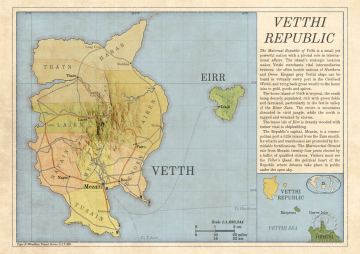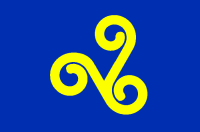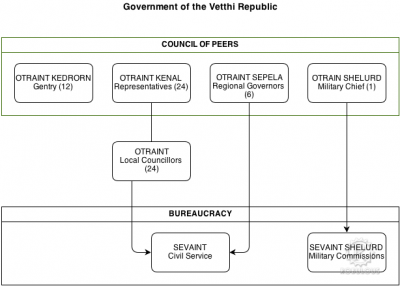Vetthi Republic
The Vetthi Republic is a prosperous island nation which plays a crucial role in trade and international affairs. Its position in the Vetthi Sea north of Ororr makes it a strategic trade hub between Anrel, Harthera and Ororr.
- Name: The Vetthi Republic
- Government: Participative Democracy
- Capital: Mezain
- Foundation: c.700 BME
- Religion: Therism

With its fiercely independent culture and strong maritime tradition, Vetth has taken advantage of Ororrplugin-autotooltip__small plugin-autotooltip_bigOrorr
Ororr [o-ROARR, ɒ̝rɔ'ɾ], also called the Holy Motherland of Ororr, is a theocratic nation in Anásthias, one of the world's great powers. It the largest nation in the world, perhaps the largest empire in history, occupying the entire northwest of the continent between the mountains and the sea. Ororrlanguagelanguagelanguage's traditional lack of naval prowess, enabling trade to continue even in times of hostility between the great powers of Ororr and Hartheraplugin-autotooltip__small plugin-autotooltip_bigHarthera
The Hartheran Union, commonly named Harthera, is an imperialist maritime nation state dominating the northeast of Anásthias. It is one of the two great powers of the modern epoch, arguably the most technologically and militarily powerful nation in the world, only matched by the vast size and wealth of its neighbour, viridOrorrMEOrorrOrorrOrorrOrorr. Vetth's naval technology has been superceded by Harthera during the past century, but the prosperous Vetthi merchant fleets still control a major share of the trade between Ororr and Anrelplugin-autotooltip__small plugin-autotooltip_bigAnrel Isles
Anrel [ANN-rel], or the Anrel Isles, is the most northerly island group in the Natorn Archipelago. It consists of three major islands and numerous smaller ones. The largest, colloquially if infrequently called Mainland, is divided between the kingdoms of Trésard and Narette. The island.
Geography
The Republic consists of the islands of Vetth and Eirr, plus numerous smaller islands near the coast of each. Of the two main islands, Vetth is 160 km from north to south, while Eirr is 26 km. Vetth is 300 km from the mainland coast, sufficiently distant from Ororr to have been politically isolated during the modern epoch. The Vetthi Passage separates it from the Ororran island of Maiyenet.
Vetth has a generally warm and humid maritime climate, though is subject to seasonal storms which particularly lash the north and west coasts. The island has been inhabited for many thousands of years, so the southern half has a rich and well-established green ecosystem of woods and farmland. The south of the island is densely populated with cities and intensively farmed arable land.
The north and highland centre of the island is mainly virid, apart from enclaves around the coast and some highland plantations. In terms of its natural history, in previous epochsplugin-autotooltip__small plugin-autotooltip_bigWorld History
Helevos has eight thousand years of recorded history, with archeology, artefacts and myth stretching back much further. There are two dominant views of human history: the theological view that the whole world and humanity were created some thousands of years ago in one instant of creation; the second, that all humanity descends from a race of fallen demigods called the viridEmerald EpochBMEgreenBMEAnásthiasAnásthiasBMEAnásthiasfolkloreMiyarrisGodmenBMEMEOrorrHartheraMEviridAnásthi… Vetth was joined to the mainland, so its viridplugin-autotooltip__small plugin-autotooltip_bigVirid
Referring to the Virid Kingdom of flora and fauna, toxic to human life. life is very similar to the mainland, with some local anomalies.
The centre of the island has two ranges of mountains running roughly east-west, the most precipitous being those immediately north of the capital, Mezain.
The coastal shelf is rich in greenfish, with fish and other marine foods forming half of the island's diet.
Provinces
The island is divided into seven provinces, with the southernmost four, called the “home provinces”, being heavily populated. The valley of the River Zuin is the most densely inhabited region, with a conurbation of towns and market gardens all along its length. The south of Mesain Province is drier, giving way to arid scrub. Though sparsely populated, there are a string of military forts along the southermost peninsula, keeping watch for unwelcome visitors. Beno and Pairen are largely rural and agricultural, Beno specialising in its famous fine linen, Pairen producing staple foods which flourish in its temperate climate.
The province of Napin is more wild, with a mixture of farms and greenplugin-autotooltip__small plugin-autotooltip_bigGreen
The Green Kingdom of flora and fauna includes humans, mammals, birds, whales, greenfish, and most green plants and crops cultivated by humankind. woodland fading to virid scrubplugin-autotooltip__small plugin-autotooltip_bigVirid scrubland
Virid scrubland is a region where low-growing virid vegetation is the predominant life. Scrubland is often the result of thin poor soils and low rainfall. It can also be an intermediate landscape in areas destroyed by fire.
Flora
herbs
This is in a series of articles about and jungle in the north. Lairn, between the mountains, is densely virid-forested and was all but impassable before the completion of the Thatn Road in 1053 ME.
The province of Thatn was traditionally only accessible by sea, before the Thatn Road was cut through the virgin virid forest. The province has become increasing important in the past century with the discovery of iron and silver deposits in the Thatn Hills. The city of Thatn has rapidly grown on mining wealth, and its location far inland protects it from the dangers of the storm season which regularly swamps the coast. The new-found wealth also attracted settlers from farther afield, and within the past century a number of small settlements of foreigners sprung up along the treacherous north coast, particularly refugees from Besoa, fleeing the Hartheran occupation.
Culture
Vetthi are a classic Issid-ethnic peopleplugin-autotooltip__small plugin-autotooltip_bigIssid People
The Issid people, also called the Issithai, are a West Thalsic ethnic group, traditionally inhabiting the coastal regions of northern Ororr and the Wiyel Basin.
ethnicity. There has been considerable cultural influence from the mainland of Ororr, including some immigration. The largest immigrant population are Reidan settlers, including refugees who fled Anrel in the 7th century during the Long War, as well as Besoan people who fled their homes during the Hartheranplugin-autotooltip__small plugin-autotooltip_bigHarthera
The Hartheran Union, commonly named Harthera, is an imperialist maritime nation state dominating the northeast of Anásthias. It is one of the two great powers of the modern epoch, arguably the most technologically and militarily powerful nation in the world, only matched by the vast size and wealth of its neighbour, viridOrorrMEOrorrOrorrOrorrOrorr Occupation.
Gender roles
Vetth has retained a largely traditional matriarchal society for many thousands of years, despite changes in culture and government. Under Vetthi custom, males defend and provide for the home, whilst women administer and maintain it. This has become enshrined in the Vetthi state. Women hold land tenure (in Vetthi law land is not owned, only the right to use it), so inheritance of major assets are passed down the female line. Military duties and hereditary honours, as well as weapons and some other status symbols, are passed down the male line. The balance of power between men and women has ebbed and flowed over the centuries, so that today while men dominate many households, women dominate others, particularly in the higher echelons of society.
The majority of captains in the Vetthi Merchant Fleet are men, but in recent centuries women officers and captains have become increasingly common. In politics, senior politicians tend to be women, though there are male leaders of minority political factions.
Religion
The Vetthi once followed a form of traditional Thalsic animism, with a reverence for nature spirits, vengeful furies and numerous gods of the sea. Therist missionaries began to arrive on the island from around 220 ME, gaining converts in towns and cities all across the island with their claimed abilities to cast out spirits and perform “miracles”. The Vetthi nobility were originally tolerant though dismissive of the new faith, but fearing domination by Ororr, there were a number of attempts to curb conversions and ban missionaries from doing their work. Therismplugin-autotooltip__small plugin-autotooltip_bigMother Church of Ororr (Therism)
The Mother Church is the state religion of Ororr, which combines both religion and government in one institution. It is based on the teachings of the Great Prophet Therion, who in the early decades of the modern era raised an army that conquered much of northwestern OrorrOrorrOrorrOrorrOrorrMEMEOrorrMEMEOrorrOrorrHerHerHerHerHerHerHerHerHerher persisted for another hundred years, local worshippers being separate from the Mother Church. In 323 MEplugin-autotooltip__small plugin-autotooltip_bigModern Epoch (ME)
The Modern Calendar is a dating system acknowledged throughout the Civilised World. It numbers years from the Modern Epoch, abbreviated ME and BME (Before Modern Epoch). It is also called the Modern Era.
Calendar
This is in a series of articles about calendars and dating systems.OrorrHartheraHMOrorrHartheraOrorrOrorrHMHartheraHMHartheraOrorr Ororr attempted a naval conquest of Vetth in order to bring what it considered a corrupt and heretic church back into the fold, but storms sank the Ororran fleet without a trace, before even reaching sight of the island.
Today the majority of Vetthi are Theristplugin-autotooltip__small plugin-autotooltip_bigMother Church of Ororr (Therism)
The Mother Church is the state religion of Ororr, which combines both religion and government in one institution. It is based on the teachings of the Great Prophet Therion, who in the early decades of the modern era raised an army that conquered much of northwestern OrorrOrorrOrorrOrorrOrorrMEMEOrorrMEMEOrorrOrorrHerHerHerHerHerHerHerHerHerher and follow the teachings of the Great Prophet, but the Vetthi Church remains politically independent from the mainland.
Language
The modern Vetthi language is derived from ancient Issithai, once spoken all along the northern coast of Ororr but now largely replaced with Doroun . Modern Vetthi is still a classic Issid languageplugin-autotooltip__small plugin-autotooltip_bigLanguages
List of human languages and dialects, contemporary and extinct.
Language
language
This is in a series of articles about Languages and Communication.
topics sidebar cult1 though at least a third consists of loan words, mainly from Doroun but also from disparate parts of the world due to the wide ranging of Vetthi sailors.
Protocol
Vetthi names can be long and complicated, containing in them not only the person's rank and profession, but their family origins, history and distinguishments. They can seem impossibly lengthy and cumbersome to foreigners, given that use and misuse of Vetthi naming conventions is a marker of class and education.
Government
The Vetthi Government is a republic, with traditions that date to the mists of time. The heart of governance is an elected assembly of twenty-four “peers”, who take decisions on laws and policy. The government is led by a “Teller”, once the official spokesperson of the assembly but now the leader of the nation.
Flag
The Vetthi blue ensign was adopted in the sixth century after the island's steady conversion to Therism. The golden triskelion represents the Therist “world” symbol, set in the waves. Gold and blue represent the islands wealth coming from the sea.
History
The island has evidence of human habitation dating back five thousand years to at least 4000 BME. It certainly saw an influx of refugees from the Ves Jaen Wars, fleeing the mainland. In previous epochs the island was much larger, up to three times larger at its greatest extent, so that the modern landscape was the central uplands, mostly virid-forested excepted around Mezain, an ancient Issid town.
Prior to the Republic, Vetth was ruled by a series of Queendoms, essentially city-states who contested with each other for dominance. Tsepin in the west and Vetsuin in the Zuin valley were the most famed, though both cities were eventually destroyed.



